

James Wong
5 Days Ago
Mazda's first EV is proudly left of centre. There's a lot to like about how it looks, feels and drives, but we're less enthused with the price.
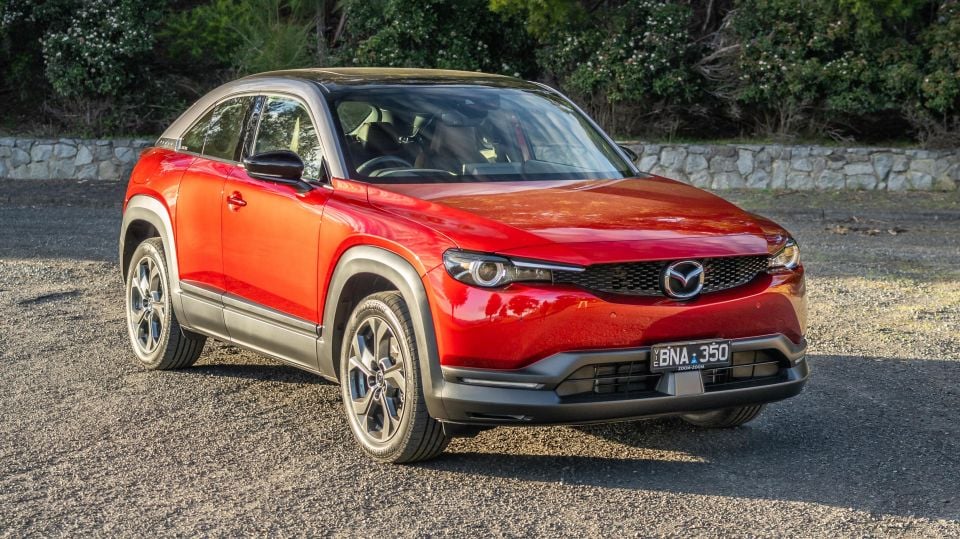
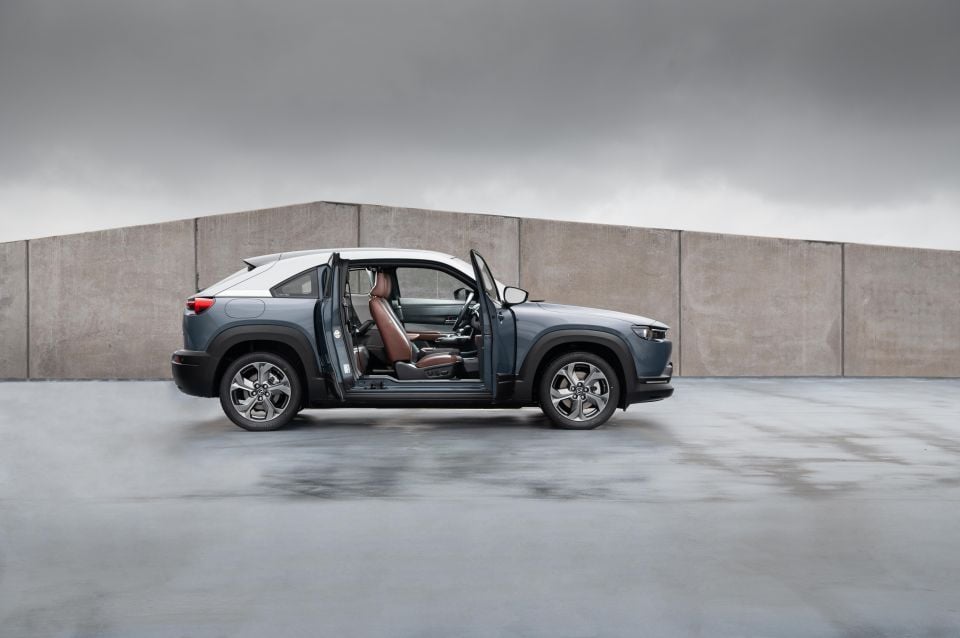

Senior Contributor
New from
$33,990
excl. on-roads

Senior Contributor
New from
$33,990
excl. on-roads


Senior Contributor
New from
$33,990
excl. on-roads

Senior Contributor
New from
$33,990
excl. on-roads
Quickly see how this car stacks up against its competition. Select any benchmark to see more details.
Take advantage of Australia's BIGGEST new car website to find a great deal on a Mazda MX-30.
Credit where it’s due, Mazda’s first electric vehicle goes against the grain.
While the 2021 Mazda MX-30wears the coveted ‘MX’ nomenclature – short for ‘Mazda Experiment’ – it’s no traditional sports car.
Rather, it’s a CX-30-sized small crossover with less room inside, a fastback roofline, beautiful light signatures, a contrast roof option, and rear-opening ‘freestyle’ back doors that enable a pillar-less side profile.

The 21st century’s take on a coupe, perhaps?
It’s also targeted at city slickers, given its small-capacity (Mazda terms it “right sized” but let’s call a spade a spade) battery pack and 224km maximum driving range.
Still, it ought to be quite light and charge up quickly as a result.
Watch our detailed video review below:
There is just the one spec level available at launch: the most luxurious Astina. The price is a bit steep considering the driving range, at $65,490 before on-road costs.
The most expensive part of any EV is its battery pack, so the Mazda’s small-capacity power storage device should have kept the sticker price down. But then again, Mazda has a lot of R&D budget to recoup.
Bottom end EVs include the Nissan Leaf at $49,990, Hyundai Ioniq at $49,970, and MG ZS EV at $44,990 (drive-away for the latter).

Mazda MX-30 Electric competitors include the Mini Cooper SE flagship ($62,825) and BMW i3s ($71,900) that offer similar urban-friendly range. And given its cool look and designer cabin, these are the Mazda’s true foes.
Then there’s the Hyundai Kona Highlander ($66,000), Kia Niro EV Sport ($65,990), and Tesla Model 3 Standard Range Plus ($62,900) all capable of greater mileage per charge.
If you love the look and feel of the MX-30 Astina but want something cheaper or easier to cover long distances with, a petrol-powered version in the same spec grade costs $40,990.
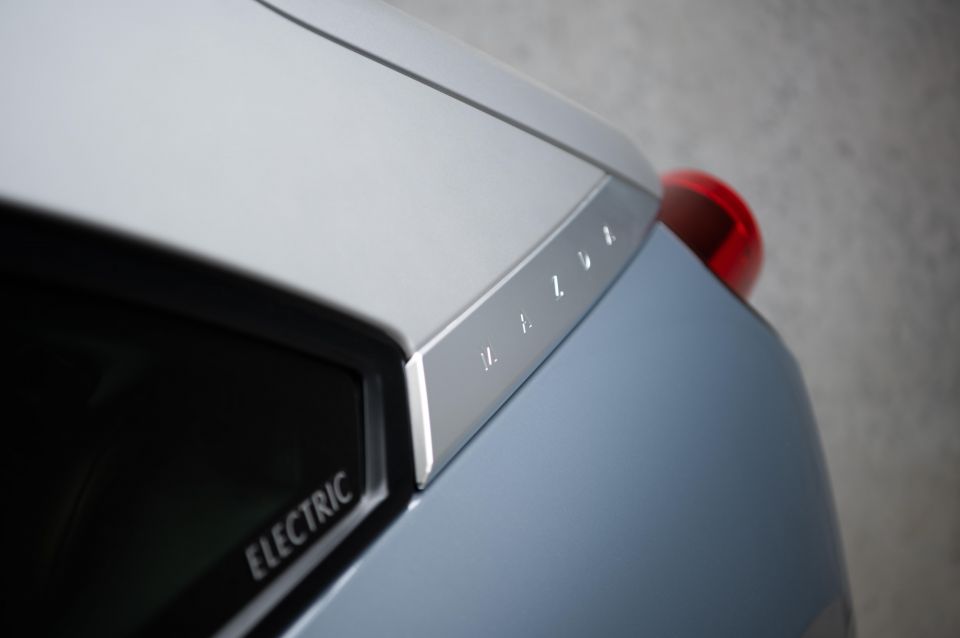
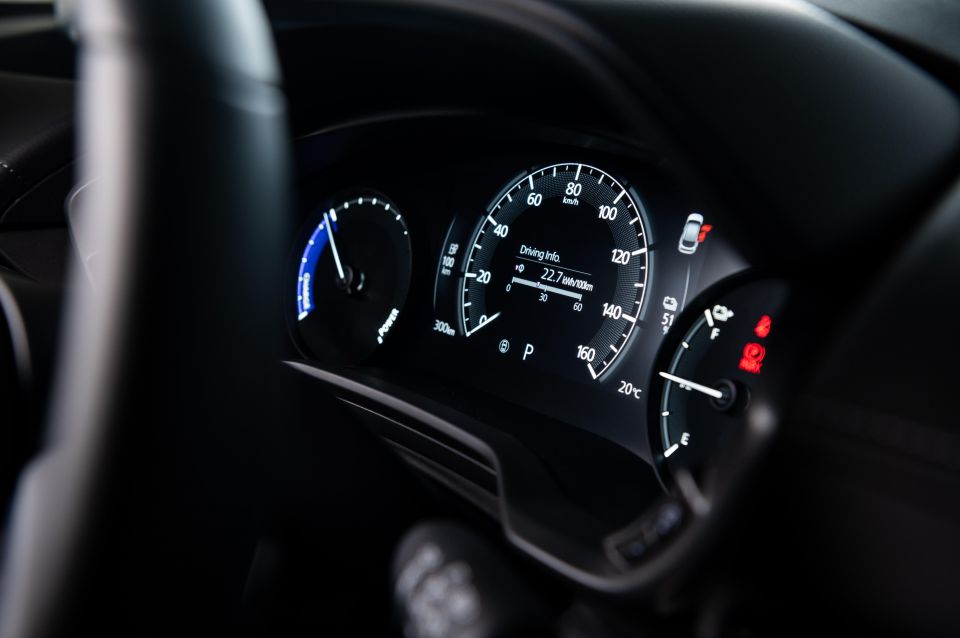

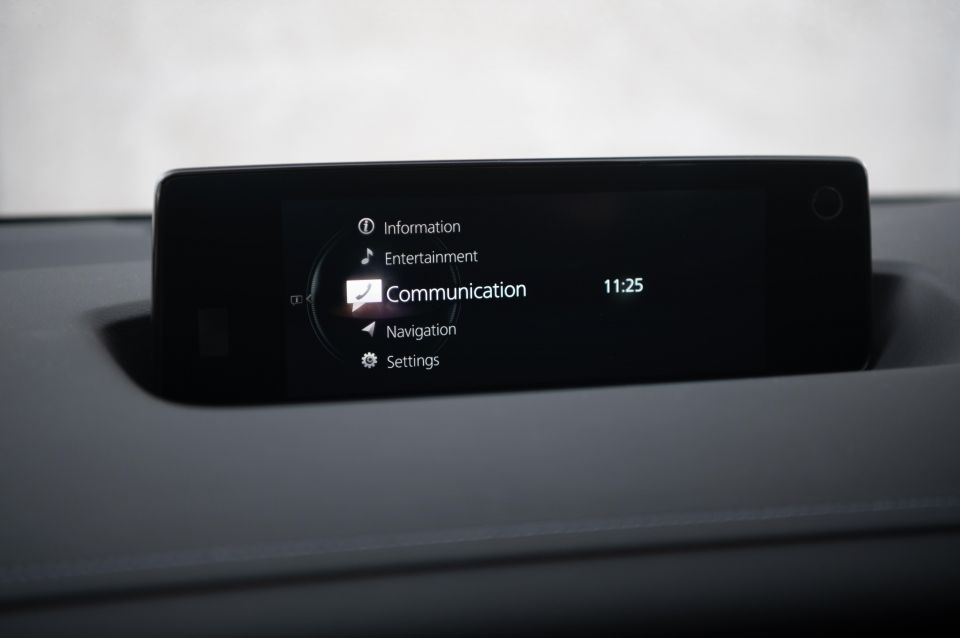
You couldn’t accuse the Mazda MX-30 Astina of being under-specified with creature comforts.
On the outside you get 18-inch ‘bright finish’ alloy wheels, auto-folding and heated power mirrors, a sliding glass sunroof, automatic LED headlights, rain-sensing wipers, proximity key-fob access, and parking sensors at both ends.
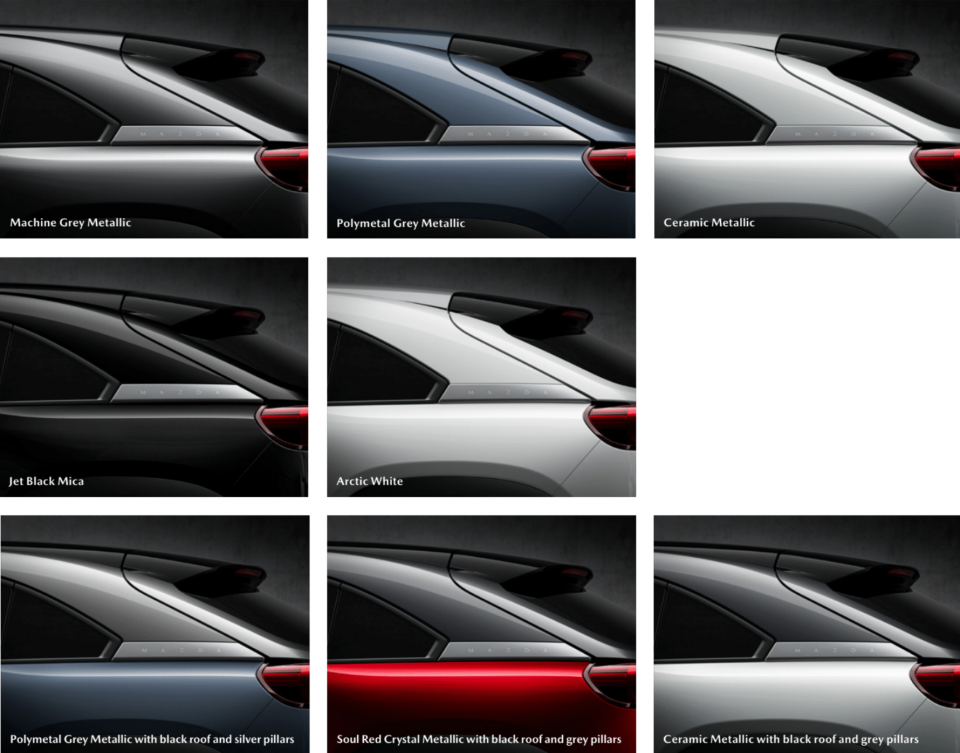
Colour choices include Machine Grey Metallic, Polymetal Grey Metallic, Ceramic Metallic, Jet Black Mica, and Arctic White. You can also option a black roof with grey pillars on certain colours.
On the inside there’s vintage brown faux leather trim, heated front seats with 10-way power adjustment and memory presets on the driver’s side, touchscreen-operated climate control, a TFT multi-information display, and an auto-dimming rear-view mirror.
Infotainment is displayed on a 8.8-inch screen operated with a rotary dial and buttons, and comprises satellite-navigation, wired Apple CarPlay and Android Auto, a 12-speaker Bose premium sound system, digital radio, and a 360-degree camera.

The MX-30 received top marks from crash-tester ANCAP, which gave it a 2020 five-star rating and scores of 93 per cent for adult protection, 87 per cent for child protection, 68 per cent for vulnerable road-user protection, and 74 per cent for safety assist functionality.
Safety features include 10 airbags; autonomous emergency braking that detects pedestrians and cyclists, and works in reverse and at junctions; lane-keep assist with steering; rear cross-traffic alert; blind-spot monitoring; collision alert; and a tyre pressure monitor.
We found the lane-keeping aid didn’t always keep the MX-30 centred, and sometimes took a second to correct course. But the cross-traffic alert and blind-spot systems were very helpful.

The Mazda’s pièce de résistance is its interior, which melds a sense of premium trim and touchpoint quality with an adventurous aesthetic.
Much of it is familiar from other new Mazda products: thin-rimmed heated steering wheel that telescopes over a 70mm range, wide aspect-ratio centre screen and accompanying rotary dial, and various switchgear. Ditto the instrument display and head-up display for the most part, bar the battery/motor gauge on the left.
The driver and passenger sit low for an SUV but high for a coupe (if that makes sense), with lots of adjustment on offer for leggy people, and the heated seats themselves match their neat design with plenty of support for long drives.
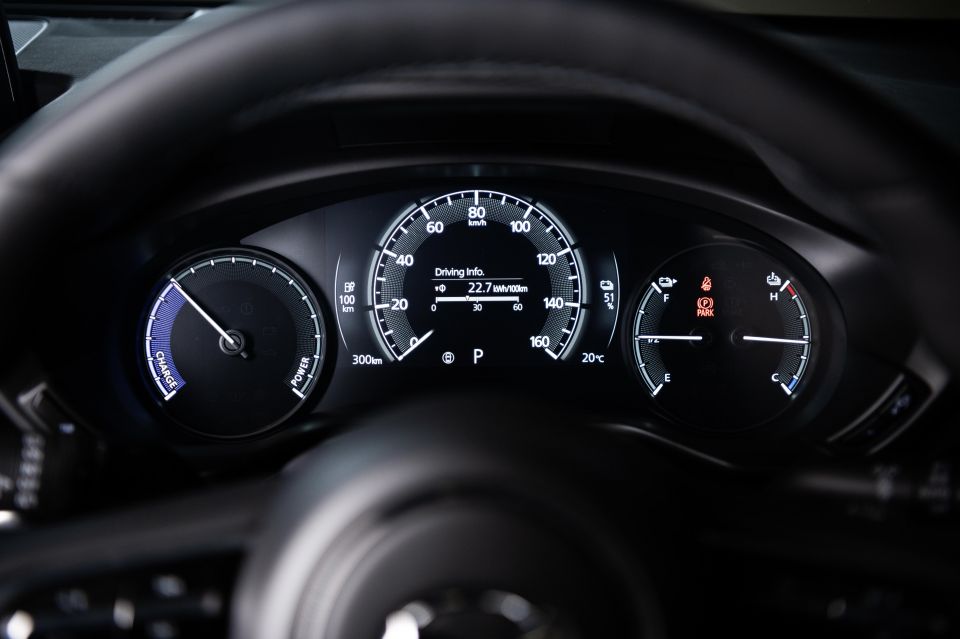
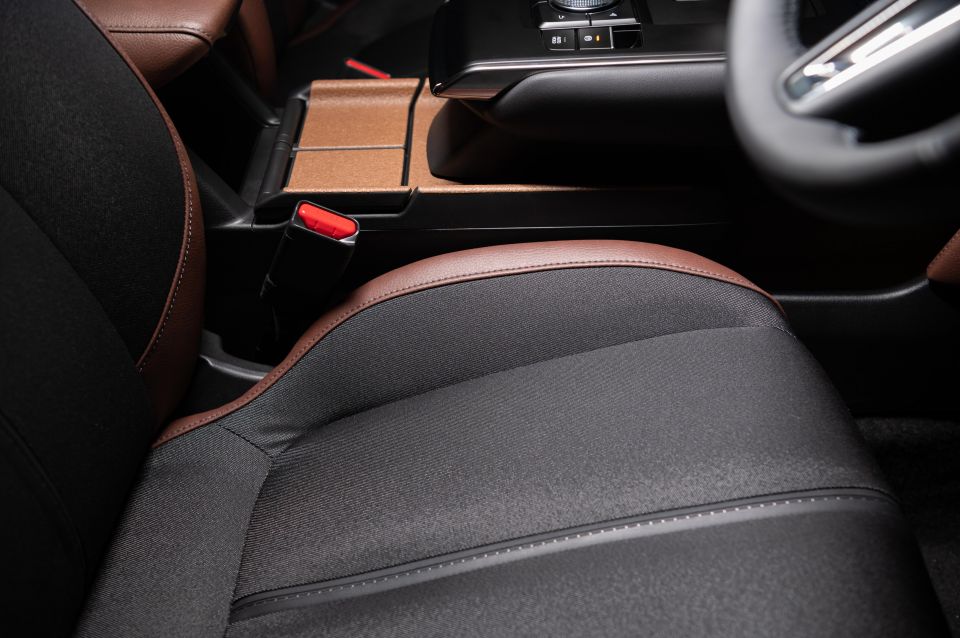
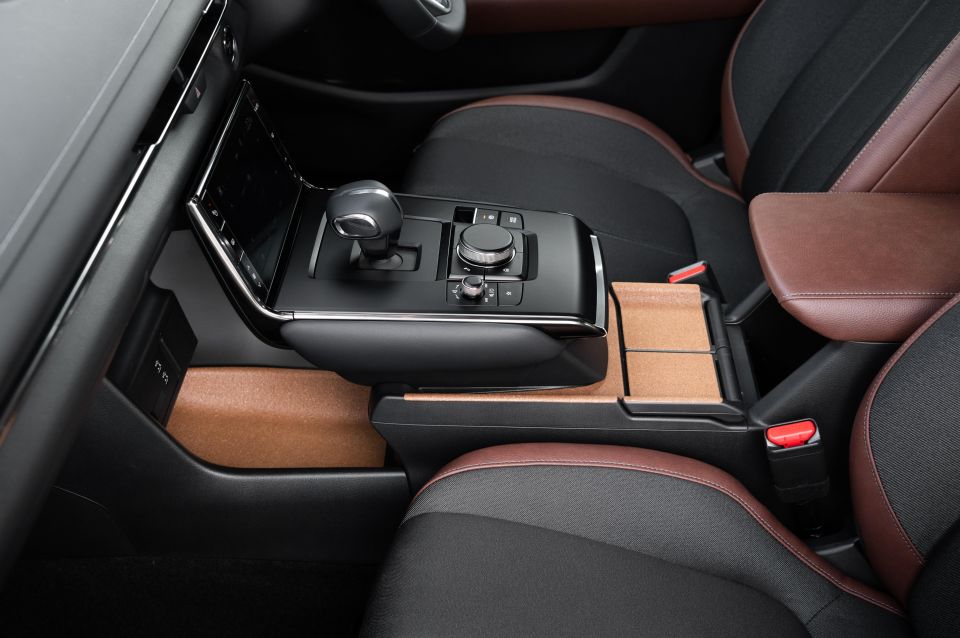
The ‘Maztex’ vegan leatherette made with water rather than solvents, ‘floating’ console enabled by the chubby shift-by-wire gearstick that covers a big open area below the fascia, light grey upper door trims made from recycled PET bottles, and the use of sustainable cork along the centre section, are all unique to the MX-30.
It feels light and airy, which adds a sense of spaciousness. Plus green materials are a subject that deserve more attention.
Opinion: Sustainable cabin materials should be a sexy subject
Also unique is the 7.0-inch touchscreen unit that controls the HVAC system which, in my opinion, looks great but is not as user-friendly as buttons and dials, which offer better eyes-off feedback and tactility. Perhaps that’s just me. In its defence, it does have some swish yet restrained graphics.

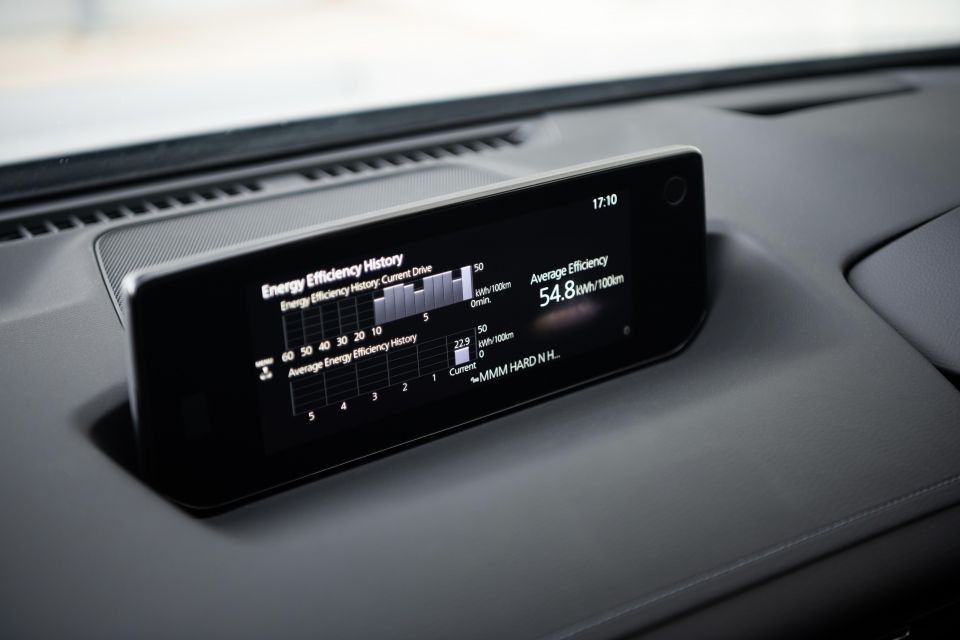
The infotainment is typical of most modern Mazdas. There’s an 8.8-inch infotainment screen nestled atop the dashboard, controlled with a rotary dial on the transmission tunnel. It’s a huge step forward from the old MZD Connect system, with slick graphics and snappy responses.
Apple CarPlay and Android Auto are both included, as is factory satellite navigation, DAB+ and a very sharp 360-degree parking camera display. The Bose audio system has 12 speakers and offers crisp sound quality and chunky, low-distortion bass.
Outlets include two 2.5A USB ports, a 12V DC socket, and a 220V/150W AC outlet. I wouldn’t mind a 3.6kW socket like a Hyundai Ioniq 5, and some USB-Cs though…

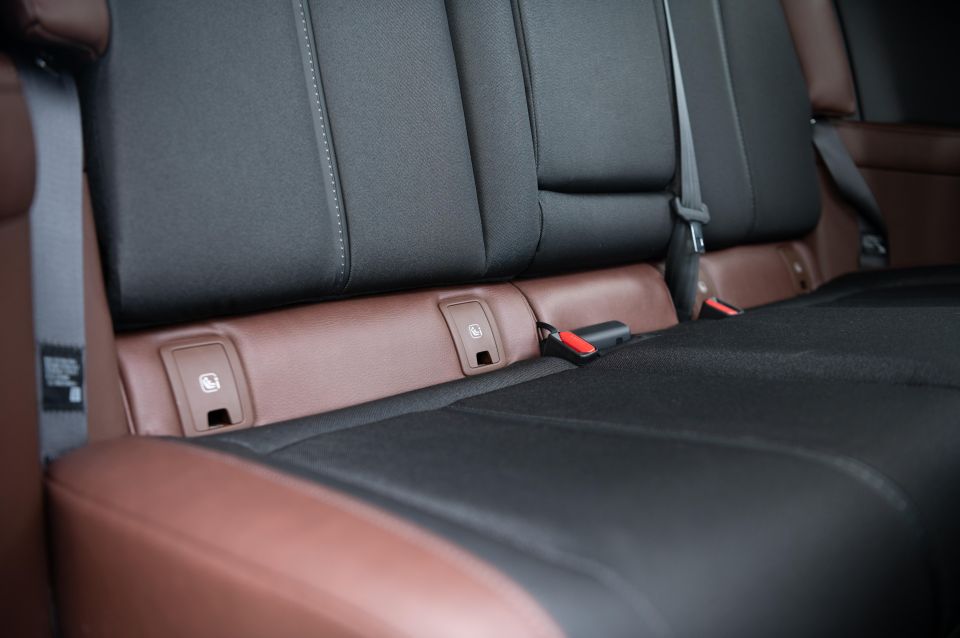
Things aren’t quite so rosy in the back seats, which are accessed through those funky, reverse-opening Freestyle Doors. Mazda has experience with these doors – the RX-8 featured them – but even with a focus on improving visibility the windows are quite small.
Legroom is limited, though headroom is surprisingly good in spite of the sloping roofline. Realistically it’s a space for children or shorter adults on short trips. Watch 185cm tall Paul Maric test the rear seats in the video embedded above.
Boot space is 311L under that curved boot lid (enough for 4 x 115cm suitcases according to Mazda, whereas we fit a large check-in suitcase and a backpack side-by-side), and the rear seats fold down 60/40. A tyre-repair kit lives below the floor.

There’s no Tesla-style ‘frunk’, but rather the car’s drive components. The MX-30 sits on the same core platform as a petrol-fired Mazda CX-30, rather than a bespoke EV skateboard.
The MX-30’s motor sends 107kW of power and 271Nm of torque to the front wheels through a single reduction gear, and draws power from a 35.5kWh battery pack with liquid cooling.
The real-world driving range claim is about 224km, which is half what a Kona Electric or Niro offer, but about par with a Mini Electric. My 17kWh per 100km average consumption shows that a 200km-ish real world range is achievable unless it’s very cold or you’re a lead-foot.
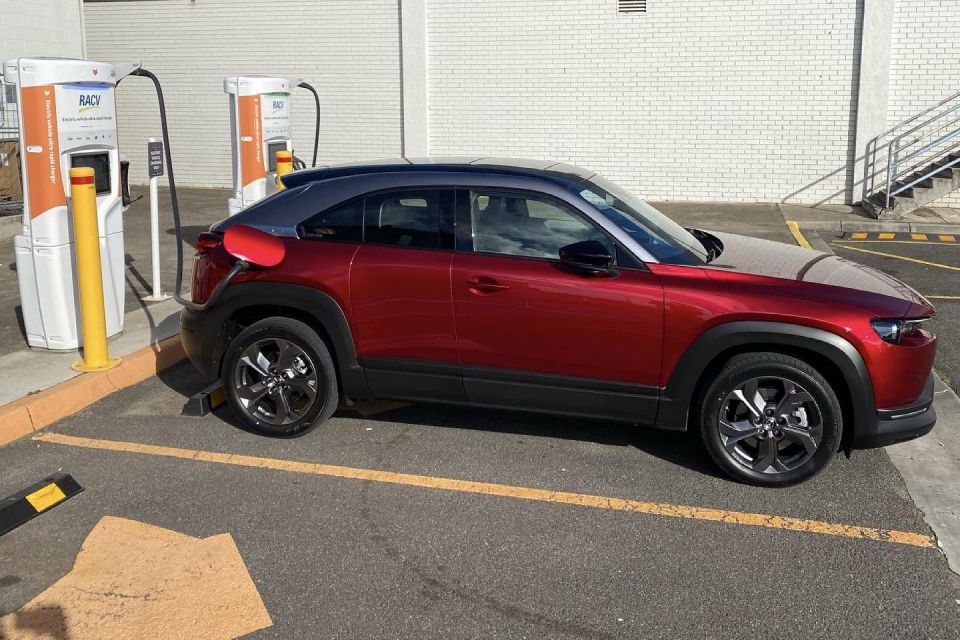
One upside of a small-capacity battery like this one is that it should charge quite quickly, though its maximum DC rate is around 50kW which is an inhibitor.
A 6.6kW garage AC wallbox with Type 2 plug running single-phase will charge the battery from 20 per cent to 80 per cent in about three hours before tapering near the end of the cycle (as per all EVs). A CCS Combo 50kW public DC charger will do the same in 36 minutes.
If you’re desperate, the supplied emergency cable plugged into a 240V standard power socket will charge you from 20 per cent to 80 per cent in about nine hours.
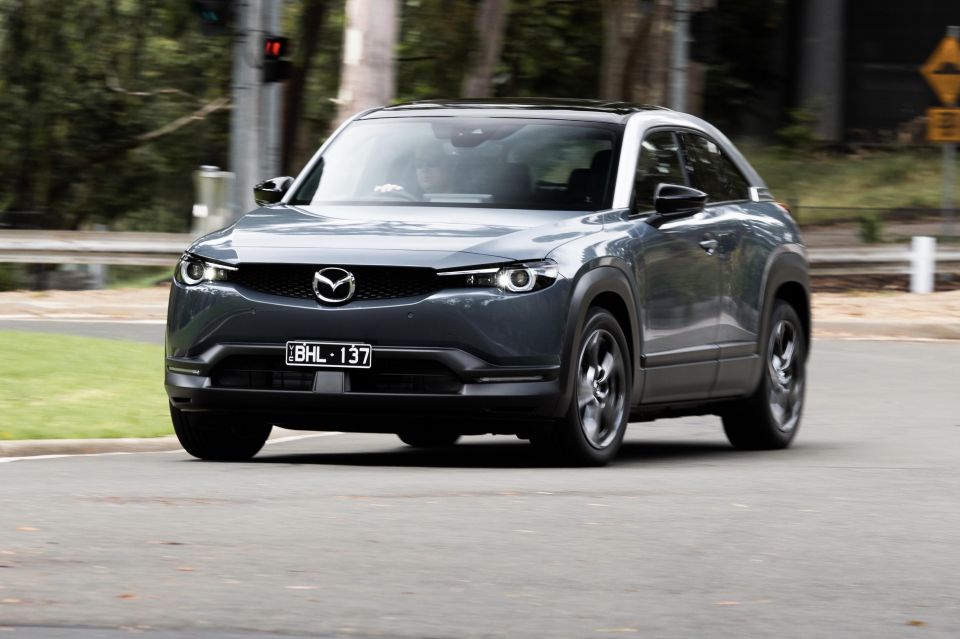
While a Tesla wants to melt your face with its instant electric acceleration, the Mazda MX-30’s low-output motor offers a more stately and relaxing experience. It’s extremely smooth, but eases rather than catapults you to freeway speeds.
If you’ve ever pushed the right pedal in a Kona Electric an experienced torque steer and axle tramping, this might come as a relief.
I rather enjoyed the subtle fake ‘engine’ noise piped into the cabin which matches your throttle inputs, which I think adds a sense of involvement for the driver. Trust me, it’s not as daft as it sounds. Then again, colleague Paul hated it…
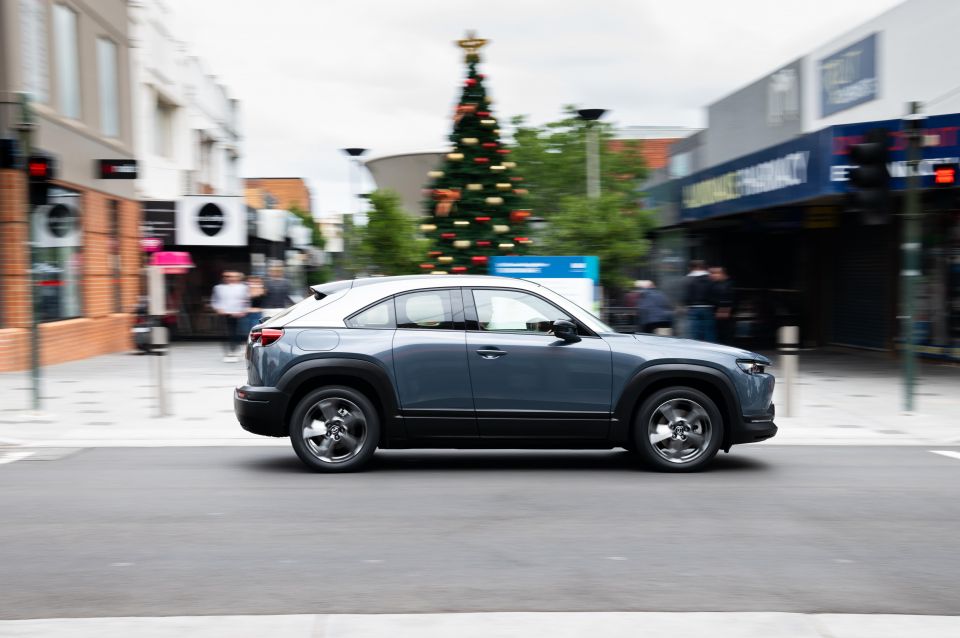
Find out more about the car
The paddle shifters let you modulate the degree of resistance from the regenerative brakes, from free-wheeling to something approaching one-pedal driving, and we found the integration of everything (including the transition from brake regen to mechanical braking) very smooth.
Mazda clearly spent a lot of time honing the system, which is very Japanese. It’s no rocket ship and the range limits your applications, but it’s all very smooth and drama-free, and even offers some aural engagement.
That relative lightness (~ 1700kg) also allows the MX-30 to feel more agile and nimble than most fellow price-point EVs based on combustion cars, with a balanced chassis and springs and dampers that control rebound and compression well. The steering also offers nice weighting.

It also uses a bespoke take on the company’s ‘G-Vectoring’ system that optimises front to rear load transfer by subtly adjusting motor power delivery in dynamic situations like tight turns or slaloms.
Much like other new Mazdas, the MX-30 is refined in terms of tyre- and A-pillar wind-noise suppression, though the B-pillar let some noise in. I saw 68dB on my coarse-chip 100km/h surface which is upper percentile for any vehicle, even premium ones.
To reiterate, the MX-30’s pace might lag, but its refinement and agility are first rate for an EV.
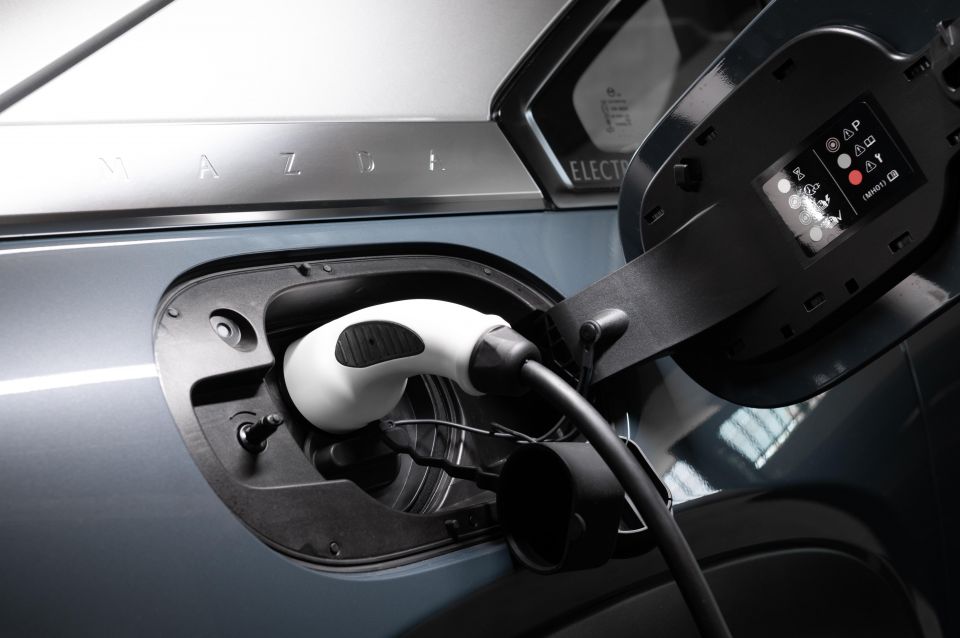
The Mazda MX-30 is covered by the brand’s regular five-year, unlimited-kilometre warranty, while the battery pack is covered for eight years with a degradation cutoff.
Servicing intervals are annual or 15,000km, and a five-year Mazda Service Select plan costs $1273.79 all up – equal to $254.75 per visit.
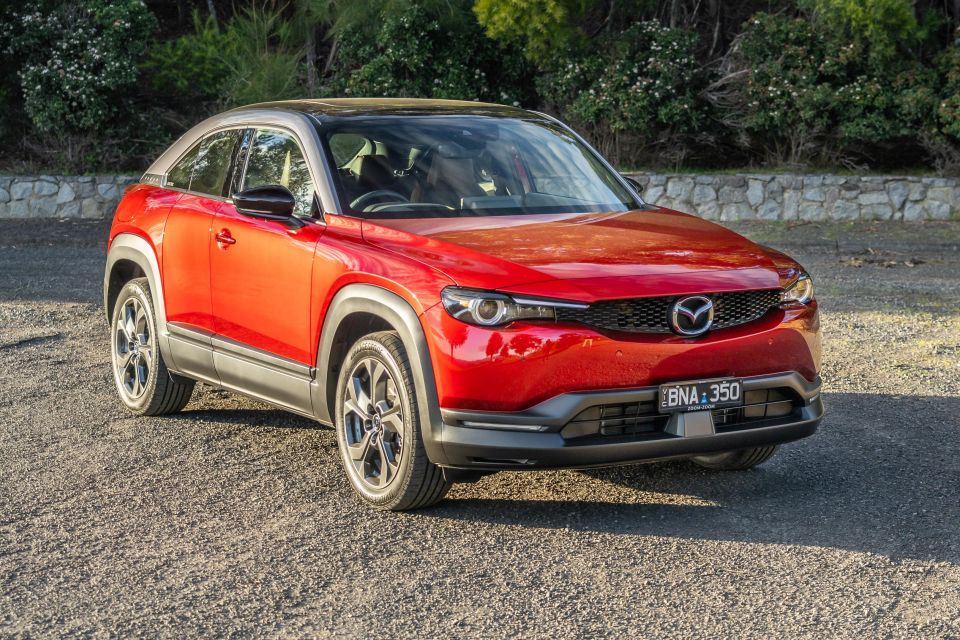
You can’t argue with the Mazda’s attention to detail inside, novel design outside, agile yet refined driving character, and nicely calibrated drivetrain.
Even the modest driving range would be fine were the price more realistic.
But at the end of the day, as pleasant and unique as Mazda’s first EV is, it’s going to be a hard sell to all but the brand’s most devoted followers at around $70,000 on the road. Just like the BMW i3 was.
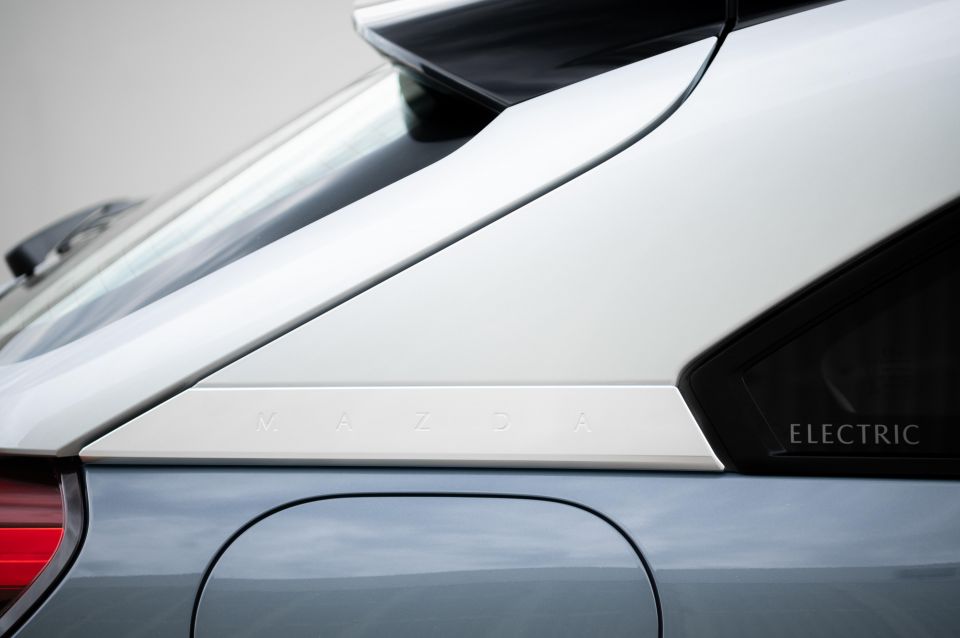
Click the images for the full gallery
MORE: Everything Mazda MX-30
Take advantage of Australia's BIGGEST new car website to find a great deal on a Mazda MX-30.


James Wong
5 Days Ago
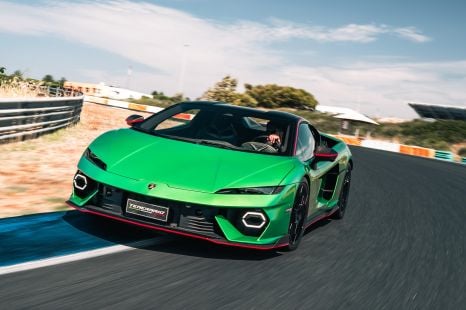

Alborz Fallah
4 Days Ago


Andrew Maclean
3 Days Ago
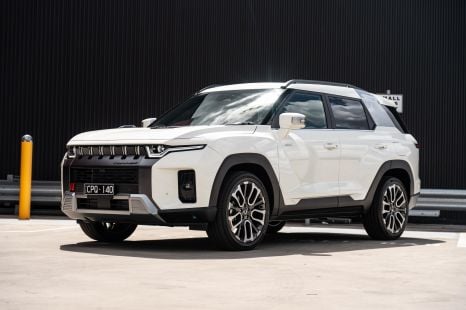

Max Davies
3 Days Ago


Matt Campbell
2 Days Ago
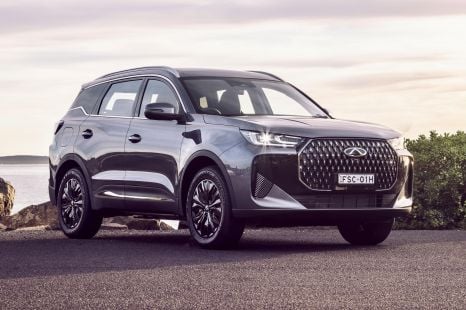

Max Davies
19 Hours Ago